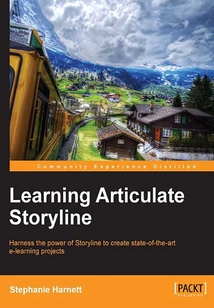舉報 

會員
Learning Articulate Storyline
最新章節(jié):
Index
Thisbookprovidesone-on-onetutoringtohelpyouquicklygetuptospeedwiththebasicswhilealsolearninghowtobestapplyStorylinefeaturesinthecontextoftheworkyoudo.Ifyou’reane-learningdeveloper,writer,designer,subjectmatterexpert,oralloranyoneofthese,thisbookisforyou.Thisbookisnotjustfornovices,butalsoforseasoneddevelopers,transitioningfromPowerPointandArticulateStudio’09,andforthosewhoarealreadyworkingwithStoryline.
目錄(90章)
倒序
- 封面
- 版權信息
- Credits
- About the Author
- About the Reviewers
- www.PacktPub.com
- Preface
- Chapter 1. Creating a Story
- Launching Storyline
- Creating a new story
- Storyline interface
- Preparing a story
- Creating a story based on a template
- Chapter 2. Adding Content into your Story
- Working with the Timeline
- Inserting content into a slide
- Working with slides
- Customizing slide design
- Adding animations and transitions
- Previewing your work
- Summary
- Chapter 3. Adding Interactivity
- Follow along…
- Working with states
- Working with triggers
- Adding hyperlinks
- Adding buttons
- Quick publishing
- Summary
- Chapter 4. Adding Characters and Audio
- Examples of the human touch done well
- About Storyline characters
- About character conversations
- Creating interactive conversations
- Summary
- Chapter 5. Extending Slide Content
- About layers
- Adding content to a layer
- Showing and hiding a layer
- Features that extend a slide's content
- Hotspots
- Summary
- Chapter 6. Using Variables to Customize the Learning Experience
- Storyline variables
- Types of variables
- Creating variables
- Using variables
- Data Entry
- Refining action based on conditions
- Summary
- Chapter 7. Creating Learning Paths
- Principles of branching
- Controlling presentation order
- Understanding slide properties
- Customizing slide navigation
- Summary
- Chapter 8. Testing Learner Knowledge
- Question categories and types
- Creating editing and customizing questions
- Scoring results and review
- Converting static content
- Customizing your quiz
- Summary
- Chapter 9. Adding Visual Media to a Story
- Working with visual media
- Supported media
- Bringing media into a story – part 1
- Bringing media into a story – part 2
- Screen recordings and interactive simulations
- Creating emphasis with pans and zooms
- Tips on working with video
- Summary
- Chapter 10. Publishing your Story
- Previewing projects
- Customizing the Player
- Chapter 11. Rapid Development
- Concept of reusability
- Leveraging existing assets
- Build once and reuse many times
- Best practices for organizing assets
- Productivity boosters
- Summary
- Appendix A. Appendix
- The Articulate community
- Design and development
- Working with media
- Assets and templates
- Accessibility
- Inspiration
- Index 更新時間:2021-08-13 16:17:16
推薦閱讀
- Data Visualization with D3 4.x Cookbook(Second Edition)
- Java EE框架整合開發(fā)入門到實戰(zhàn):Spring+Spring MVC+MyBatis(微課版)
- 無代碼編程:用云表搭建企業(yè)數(shù)字化管理平臺
- aelf區(qū)塊鏈應用架構指南
- Mastering Swift 2
- Effective Python Penetration Testing
- 打開Go語言之門:入門、實戰(zhàn)與進階
- Vue.js應用測試
- 進入IT企業(yè)必讀的324個Java面試題
- Java程序設計教程
- Mastering Clojure
- Python面向對象編程(第4版)
- 大話C語言
- Java EE框架開發(fā)技術與案例教程
- 測試架構師修煉之道:從測試工程師到測試架構師(第2版)
- Swift語言實戰(zhàn)晉級(第2版)
- Java從入門到精通(微視頻精編版)
- 數(shù)據(jù)結構案例教程:C語言版
- 寫給設計師的技術書:從智能終端到感知交互
- 思維黑客:讓大腦重裝升級的75個超頻用腦法
- jQuery權威指南(第2版)
- Mastering Python Data Analysis
- 程序設計基礎(C語言)實驗指導與測試(第2版)
- JavaScript Promises Essentials
- R的極客理想:高級開發(fā)篇
- ThinkPHP實戰(zhàn)
- 軟件自動化測試實戰(zhàn):基于開源測試工具
- 實戰(zhàn)Python設計模式:可復用面向對象軟件開發(fā)實踐
- Java從入門到精通(實例版)(第2版)(軟件開發(fā)視頻大講堂)
- JavaScript and JSON Essentials

